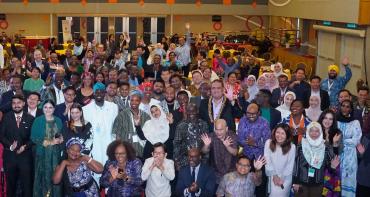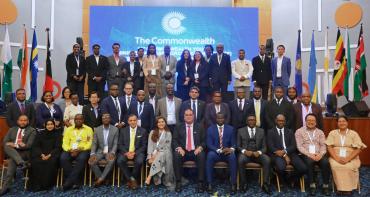The Global Youth Development Index, an initiative of the Commonwealth Secretariat, ranks 183 countries according to the prospects of young people in employment, education, health, civic and political spheres.

The world’s youth population is at an all-time high, at 1.8 billion people aged 15 to 29, yet the potential for ‘Generation Hope’ to contribute to a happy, healthy and prosperous future for all could be dashed by widespread joblessness, unequal access to health and education and lack of political influence. This is the conclusion of a major new index and report published today.
The Global Youth Development Index, an initiative of the Commonwealth Secretariat, ranks 183 countries according to the prospects of young people in employment, education, health, civic and political spheres. Looking at 18 indicators including literacy and mental disorder rates, financial inclusion and voter engagement, the index both showcases the best-performing countries and serves as a warning light for low-scoring countries.
Commonwealth Secretary-General Patricia Scotland said: “The index throws down a challenge to policy-makers everywhere: without action to promote young people’s empowerment, boosting opportunities for employment and opening up spaces for political dialogue, countries will be squandering their most precious resource and storing up problems for the future.”
The index shows that:
- The top ten countries, with the exception of Australia and Japan, are from Europe. The ten lowest-ranked countries are all from Sub-Saharan Africa, however the region also recorded the largest improvement in the last five years.
- Youth unemployment is a spectre that looms as threateningly in developed countries as in the developing world, with youths at least twice as likely as adults to be jobless.
- Young women are much less likely to enjoy access to education, health services, financial services and digital technology than young men.
- Participation in formal politics is declining, underscoring growing frustration amid unmet aspirations, although digital activism, protests and volunteering are growing.
- Young people suffer disproportionately as victims of violent crime, as seen with the spike in extremism. However, young people also play an active role in peace-building.
The Global Youth Development Index shows many countries are experiencing a “youth bulge” with adolescents and young adults making up a third of the population. This offers hope of a “demographic dividend” as young people contribute towards economic growth and well-being. However, in the decades to come, as the large youth population ages, fewer young people will be responsible for supporting greater numbers of older people.
The index, which draws on multiple data sources, is published a year after world leaders at the United Nations agreed a set of 17 new global goals for sustainable development, from ending extreme poverty and inequality, to tackling climate change.
Secretary-General Scotland, who will launch the index at a ceremony at the Australian High Commission in London on 21 October, said it provides a “call to action” for governments to empower and engage young people, adding that without the active support of youth leaders it may be impossible to deliver the sustainable development goals by their target date of 2030.
“The adolescents and young adults who make up ‘Generation Hope’ have huge aspirations and enormous capabilities, but too often they face barriers in realising their potential as productive citizens. To make good on the promise and dreams of this generation and to forge a brighter future for all, we need to invest in young people’s health, education, digital skills and offer meaningful opportunities for employment, participation and individual fulfilment,” the Secretary-General said.
Top ranked countries
The top ten countries globally in the 2016 Youth Development Index are: Germany (1), Denmark (2), Australia (3), Switzerland (4), United Kingdom (5), Netherlands (6), Austria (7), Luxembourg (8), Portugal (9), Japan (10).
The top ten Commonwealth member countries are: Australia (3), United Kingdom (4), New Zealand (11), Canada (14), Malta (20), Barbados (28), Brunei (31), Sri Lanka (31), Malaysia (34) and Cyprus (38).
In 2016, the global average youth development score was 0.616, slightly ahead of the Commonwealth average of 0.606. The index however shows Commonwealth member countries registered larger gains in youth development than the global average.
Dr Selim Jahan, Director of the UNDP Human Development Report Office, said:
“The YDI is an admirable effort and timely contribution by the Commonwealth Secretariat to fill a critical gap in the global development landscape. I hope the YDI will underscore the importance of collecting more development data at national and sub-national levels, which are disaggregated by age, gender and income.”
Achaleke Leke, a young Cameroonian peace activist and Commonwealth Young Person of the Year 2016, said:
“This report is very important for young people, especially in developing countries. It shows the urgency of investing in us, so that we can become leaders and innovators, and peaceful and productive citizens.”
Dr Joseph Muscat, Prime Minister of Malta and Chair-in-Office of the Commonwealth, said:
“Youth development can be achieved even in low-income countries by providing quality education and training and allowing young people to participate in the nation’s political, economic and social life. Health and well-being are also factors that weigh heavily in youth development, and world leaders need to focus more on promoting mental and sexual health, as well as education and nutrition.”
Ambassador Irwin Larocque, Secretary-General, Caribbean Community, said:
“Young people believe the education system does not prepare them adequately for the world of work. Rapid advances in information and communications technology over the past few decades have created a serious mismatch between the education system and the labour market. One consequence is that levels of youth unemployment in the [Caribbean] region are among the highest in the world.”
Dr Colin Tukuitonga, Director General of the Pacific Community, said:
“Advancing the status of youth in the Pacific region will require smart investment – strategic and resourceful – to integrate youth outcomes across the development agenda, with services designed to include the most marginalised and to strengthen the ability of SIDS to navigate their own futures. Statistical and analytical evidence, and strategic information to inform decision making, are integral to this journey.”
Dr Mo Ibrahim, Founder, Mo Ibrahim Foundation for Good Governance in Africa, said:
“Africa is a continent of young people our demography is completely different from the rest of the world. Within three generations, 41 per cent of the world’s youth will be Africans. By 2030, Africa’s labour force will be larger than China’s by 2035 it will be larger than India’s. This is a wonderful resource for our continent if this resource is skilled and employed. I hope we do better with our abundant human resource, and avoid a potential curse.”
Angela Crawley MP, Member of Parliament for Lanark and Hamilton East, UK, said:
“Young people deserve to have their voices heard loudly and clearly. It is time all institutions of power recognise the value that young people can bring to elected office. We may be young, but we are engaged, and our eyes are wide open to the challenges and the much needed changes that can be made.”
View the Youth Development Index
Media Contact:
Will Henley
Senior Communications Officer
Commonwealth Secretariat
Email: [email protected]



